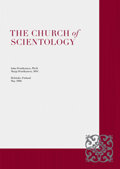The Church of Scientology, like well‑established religions, has an extensive body of literature with a full library of texts, lectures and films all dealing with L. Ron Hubbard’s research and discoveries of the nature of Man and the spirit. This library consisting of numerous books, including huge encyclopedic volumes and thousands of tape‑recorded lectures, is a visible testimony that the Church of Scientology must be acknowledged as a “book religion.” This trend coincides with such world religions as Hinduism, Buddhism, Confucianism, Taoism, Judaism, Zoroastrianism, Christianity and Islam, for example.
The massive corpus of texts, lectures and documents written, recorded and produced by L. Ron Hubbard comprises the collection of the Scriptures of Scientology. It is the basis for the efforts of the practicing members of the Church, in their often lifetime study and work towards the final goals of Dianetics and Scientology, called the states of Clear and Operating Thetan.
Authorized texts have a special role for Scientologists in transmitting knowledge and traditions which apparently are considered sacred. The continuous work in these texts is not called “theology” but “technology,” which concept has a very special meaning in Scientologist circles. Hubbard is considered to be the “source of technology” whose message is regarded as so unique and unchangeable that it cannot be interpreted by anyone. “Spiritual succession” is important but it is not related to persons as is the case in most Christian churches but to books instead; nobody in the Church of Scientology can thus claim to have any authority to be a “messenger” with a privilege to interpret Hubbard’s written or oral message today or afterwards.
A religious corporation, Religious Technology Center (RTC), in Los Angeles, was accordingly created in 1982 to hold “the ultimate ecclesiastical authority regarding the standard and pure application of L. Ron Hubbard’s religious technologies.” It is a responsible organ for “ensuring the purity of the religion and the Scientology Scriptures.” Its duty has been to safeguard Hubbard’s texts, not to interpret them.
The establishment of RTC symbolizes a clear trend towards orthodoxy which is a common characteristic of the second generation in the formation of any religion. In the process of building up a religion, for example, for doctrinal disputes or other reasons, it often has become necessary to build a “canon” for the religion, to make a difference between the dogmatic “essence” and “the other” texts to protect the message of the prophet and the purity of the doctrine against heretic and sectarian efforts.
Another important process related to this is the idea of the authority of the Mother Church. The Founding Church of Scientology of Washington, D.C., was the initial Mother Church until this role in the mid 1960s was given to the Church of Scientology in California. Since the foundation of the Church of Scientology International (CSI) in 1981 this role naturally changed to the newly established body which now serves all the Scientology churches from its headquarters in Los Angeles.





























